I have a flink job, with parallelism set to 6, few simple transformations and the issue is that when Flink is been running for more than 12 hours for example the Load on the machine start to increase, then I thought that was because of the traffic into flink during some hours of the day, but the issue is that when the traffic goes down, the load on the machine continue a bit higher, lower than before but still higher.
Use cases:
DataStream<Event> from_source = rabbitConsumer
.flatMap(new RabbitMQConsumer())
.assignTimestampsAndWatermarks(new PeriodicExtractor());
SingleOutputStreamOperator<Event> data_stream = from_source
.filter(new NullidsFilterFunction())
KeyedStream<String, Event> keyed_stream = data_stream.keyby(k->k.id);
/*one stateful operator*/
data_stream.map(new EventCount(x))
.keyBy(k -> new Date(k.timestamp.getTime()).toString())
.window(TumblingEventTimeWindows.of(Time.ninutes(30)))
.process(new MyProcessWindowFunction())
.addSink(new SinkFuncion());
/*two stateful operator*/
keyed_stream.window(TumblingEventTimeWindows.of(Time.ninutes(10)))
.process(new MyProcessWindowFunction())
.addSink(new SinkFuncion());
/*three*/
keyed_stream.filter(new FilterFunction())
.map(new AvailabilityCheckClass())
.addSink(new SinkFuncion());
/*four*/
product_view_keyed_stream = data_stream
.filter(new FilterFunction())
.map(new EventProdView(x))
.keyBy(k -> k.id+ new Date(k.timestamp.getTime()));
product_view_keyed_stream.addSink(new SinkFuncion());
/*five stateful operator*/
product_view_keyed_stream.window(TumblingEventTimeWindows.of(Time.ninutes(30)))
.process(new MyProcessWindowFunction())
.addSink(new SinkFuncion());
/*Six stateful operator with 4 ConcurrentHashMap into the state*/
keyed_stream.flatmap(new FlatMapFunction())
.addSink(new SinkFuncion());
/*seven stateful operator*/
keyed_stream.window(TumblingEventTimeWindows.of(Time.ninutes(10)))
.process(new MyProcessWindowFunction())
.addSink(new SinkFuncion());
/*eight stateful operator*/
data_stream.filter(new FilterFunction())
.keyBy(k -> k.rType.equals("ClickIdent") ? k.avidat : k.email_sha2)
.flatmap(new FlatMapFunction())
.addSink(new SinkFuncion());
Mi question: What could be the cause of the high CPU Uses when my flink job is running for more than 6 hours for example.
Insights: Heap Memory looks fine(no OOM), checkpoints are all completed, no losing events, JVM CPU consumption looks fine too, CMS GC young generation counter always increases (this worries me despite that should be normal because it is a counter, but increases too fast), this job is running as a simple java application (local execution not as a cluster with a flink installation, just java -jar flink.jar don't know if this has anything to do, just sharing information)
Thanks a lot!
